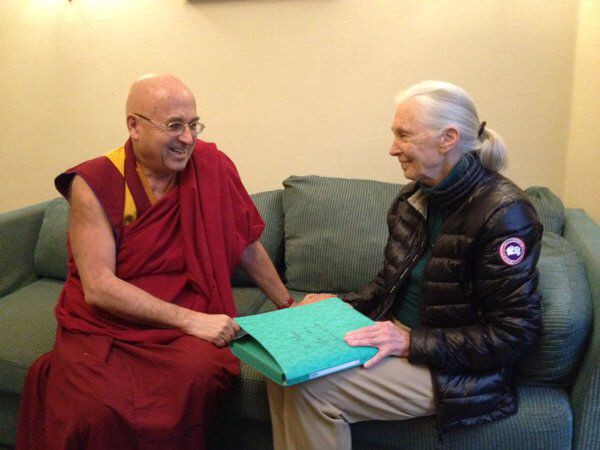
Part 2 : Becoming Aware of the Suffering behind Eating Meat
Matthieu: It seems also that slaughterhouses are guarded as if they were top-secret military facilities. You can’t see anything. But if it were shown even a little bit to people, they would find it intolerable.
Jane: There is a wonderful woman in America. She got a job in an abattoir and managed to secretly film what was going on. But the television channels would not show it.
Matthieu: TV broadcasts incredibly gory horror movies, but if you want to show a little bit of what is going on these industrial farms and slaughterhouse, nobody wants to look at it. I guess because it points at our complicity. It is a permanent torture house that goes on and on. How could we revive human values and make people more sensitive to the suffering we create?
Jane: This is what we are doing with “Roots and Shoots”, a program I am doing to engage and empower youth with service. We don’t tell the young people what to do. They sit around, talk, and choose three projects: to help people, to help the environment, and to help the other animals, including domestic ones. I bring these topics into all my talks, and they start thinking and learning, and begin to be completely horrified by what they are finding out. So, they will not tolerate those conditions when they grow up. The only way to sensitize people in the long run is working with the youth. I also meet with senators and congressmen. You have to get to their hearts. They are doing it all through their heads.
Matthieu: If we could show images about what is going on like the documentary Earthlings, people would become aware.
Jane: I had an idea about that. If you do get a film on TV that shows the horror of what is happening, people turn it off. They don’t want to look. They say: “I love animals, I can’t look at that.” They turn it off. Now, I am thinking of children. You could make a film with a very attractive child who is shown with a chicken, or a hen that has been rescued from a battery farm. She has had her beak cut. So you first see a very sweet scene of the hen in the grass with a gentle child. And the child asks: “Why is her beak like that.” Then you have a flash back. You show it being cut in the poultry battery, and quickly come back to the peaceful scene, so that it is not too much. There has to be a story. Then they ask something else and you flashback to when the hen lost all her feathers because she was in this ghastly little space. I have not found anyone to do it, but I will. You could it with animation, but people would not believe that this is true.
Matthieu: You may remember that after the movie Babe that is about a cute, smart young pig came out many children who saw it did not want to eat meat anymore.
Jane: And then it faded away.
Matthieu: Many children actually don’t want to eat meat, but their parents force them to, telling them that they need it for their health.
Jane: My sister’s grandson, when he was five, learned where a chicken came from and said: “I am not going to it that again.” That was the last one. Then he went to an aquarium and went round and round and declared “I am not going to eat a pretty fish again.” Then his mother took him to another part of the aquarium where there was less colorful fish. He watched them for a very long time and finally said, “You know, I am not going to eat any fish.” And he is only seven!
Matthieu: It reminds me of Kafka who, after having given up eating animals, said, while watching a fish in an aquarium, “Now I can look at you in peace, I don’t eat you anymore.”
(To be continued)